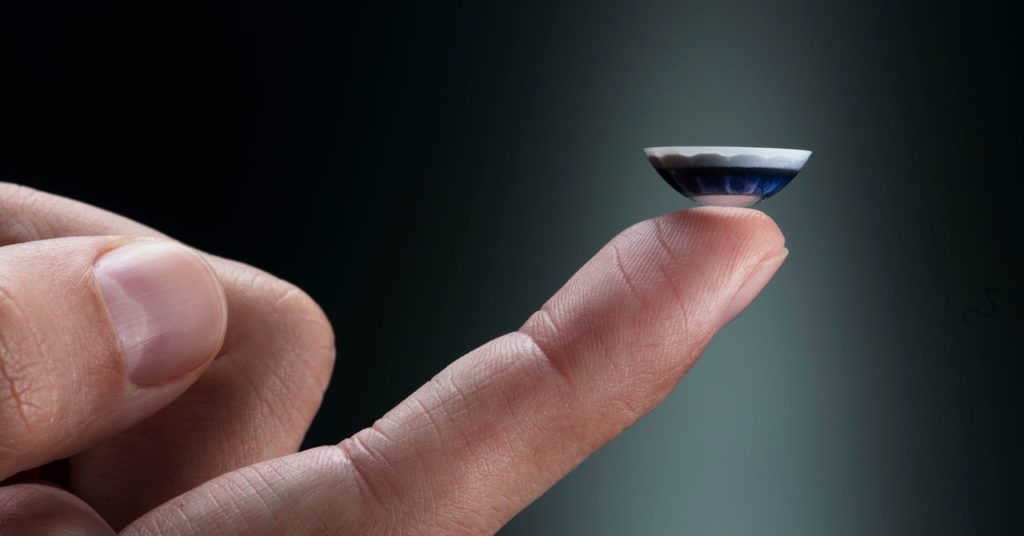The Display of the Future Might Be in Your Contact Lens
Mojo Vision’s prototypes can enhance your vision or show you your schedule—right from the surface of your eyes….


At the moment, the lens receives power via a wearable you wear on your wrist, which also handles much of the computing. Eventually, Wiemer said, he thinks the team might drop the wearable in favor of a smartphone-based solution.
Using Apps on a Contact Lens
Nevertheless, the possibilities are wide-reaching. I donned an HTC Vive Pro virtual reality headset outfitted with eye-tracking technology to get an early experience of what wearing Mojo Lens will be like.
If you’re looking straight ahead while wearing the lens, you won’t see anything visually disrupting. But peek to a corner in any direction and you’ll see icons pop up, ranging from a calendar, weather, notifications, music playback, and more. Stare at the arrow next to these icons to expand them even further to see more details—like a three-day forecast, for example—or all your calendar events for the day. It took me about a minute to figure out how to navigate the interface; it could all change at any moment, but it’s promising to see just how simple it is to use.
One of my favorite demo apps is Speech. Using only my eyes, I opened a prewritten speech, scrolled through it, and read it aloud. This app alone opens up a myriad of possibilities. Imagine sitting in a taped interview but, instead of looking at notes, you can pull up your next question with a flick of your eye without having to look down. Or if you’re filming a video, you may not need to shoot multiple takes because the script is in the dead center of your eye. Who needs teleprompters?
To those around you, it can be obvious when you’re using the contact lens. To pull up the interface you need to look at the corner of your eye—something that’s noticeable when someone is staring at you straight on, but it’s far more invisible than taking out your phone, or checking your watch. Alerts and notifications will also pop up sparingly, though I expect there’d be a way to control all of that down the road.
The lens will sit right on the cornea, and Ashley Tuan, vice president of medical devices at Mojo Vision, tells me it will be just like wearing normal contacts. The team calculated the lumens projection on the retina and found that everything is “way under the regulation,” in terms of safety standards.
“It’s a new form factor, but you as the wearer of this product, you just see content,” Wiemer assured me. “Just as you would see content if you held up a mobile phone or you put on a pair of glasses that made that content appear in the world—from the perspective of your body and your retina—it’s just light on your retina, just like light on your retina right now. The safety implications of this are something that we obviously paid a lot of attention to, but it’s a very safe product.”
They’ll Still Fix Your Vision
Mojo Vision is positioning its contact lens for consumers and businesses, but first it’s focusing on people who are visually impaired or have low vision—or vision poor enough that glasses cannot fix it. That’s because all contact lenses, smart or dumb, need to clear the Food and Drug Administration (FDA) in the US. Mojo Vision has been granted the Breakthrough Device Designation, which allows companies to fast-track development, assessment, and review for products that could help people with life-threatening or debilitating conditions—though the FDA maintains it preserves “the statutory standards for premarket approval.”
To show off the capabilities of helping people with low vision, the team threw me into a dark hotel room filled with stop signs and various other items. I was handed a stick with a prototype Mojo Lens and held it close to my eye. This one had an image sensor connected to it. Despite standing in almost pitch darkness, I could make out people in the room and the edges of the bed, and I could even read the stop sign with ease. It was almost like using night vision. The image sensor showed me the real world, but the lens increased the contrast, highlighted edges, magnified objects, and performed a few other tricks to help me see in the dark. Ideally, it will help visually impaired users navigate their surroundings a lot easier. It was impressive.
Mojo Vision is partnering with the Vista Center for the Blind and Visually Impaired in Palo Alto, California, to connect with the nonprofit’s clients and get input for the lenses during development. The company will also work with FDA experts to meet safety regulations.
If you don’t suffer from low vision, have a seat. If it takes a few years to get clearance on a device that works for the visually impaired, it will take a few more to make a smart contact lens for everyone else.




